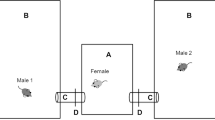Abstract
When females mate with a heterospecific male, they do not usually produce viable offspring. Thus, there is a selective pressure for females to avoid interspecific mating. In many species, females innately avoid heterospecific males; females can also imprint on their parents to avoid later sexual interactions with heterospecific males. However, it was previously unknown whether adult females can learn to discriminate against heterospecific males. We tested the hypothesis that adult females previously unable to avoid interspecific mating learn to avoid such mating after being exposed to heterospecific males. Syrian hamster (Mesocricetus auratus) females not previously exposed to Turkish hamster (Mesocricetus brandti) males can discriminate between odors of conspecific and heterospecific males, but they mate with either type of male. However, when we exposed adult females to both a conspecific male and a heterospecific male through wire-mesh barriers for 8 days, and then paired them sequentially with the two males, females were more receptive to conspecific males and more aggressive to heterospecific males. When females were paired with the heterospecific male first and the conspecific male second, no female was receptive and all were aggressive to heterospecific males. When females were paired with the conspecific male first, only 43% of females were then aggressive toward the heterospecific male. That is, interactions with conspecific males may decrease a female’s ability to properly avoid heterospecific males. Our study clearly shows for the first time that females can learn during adulthood to avoid interspecific mating just by being exposed to stimuli from heterospecific males.


Similar content being viewed by others
References
Andersson M (1994) Sexual selection. Princeton University Press, Princeton
delBarco-Trillo J, Gulewicz K, Johnston RE (2009a) Medial amygdala involvement in discrimination of same-species and closely-related-species male stimuli in estrous female Mesocricetus hamsters. Behav Neurosci 123:758–763
delBarco-Trillo J, Gulewicz K, Segal A, McPhee ME, Johnston RE (2009b) Can captivity lead to inter-species mating in two Mesocricetus hamster species? J Zool 278:308–312
Dukas R (2004) Male fruit flies learn to avoid interspecific courtship. Behav Ecol 15:695–698
Dukas R (2008) Learning decreases heterospecific courtship and mating in fruit flies. Biol Lett 4:645–647
Dukas R (2009) Dynamics of learning in the context of courtship in Drosophila persimilis and D. pseudoobscura. Anim Behav 77:253–259
Gröning J, Hochkirch A (2008) Reproductive interference between animal species. Q Rev Biol 83:257–282
Haskins CP, Haskins EF (1949) The role of sexual selection as an isolating mechanism in three species of poeciliid fishes. Evolution 3:160–169
Hebets EA (2007) Subadult female experience does not influence species recognition in the wolf spider Schizocosa uetzi Stratton 1997. J Arachnol 35:1–10
Huck UW, Banks EM (1980) The effects of cross-fostering on the behavior of two species of North American lemmings, Dicrostonyx groenlandicus and Lemmus trimucronatus: II. Sexual behaviour. Anim Behav 28:1053–1062
Irwin DE, Price T (1999) Sexual imprinting, learning and speciation. Heredity 82:347–354
Kandul NP, Wright KM, Kandul EV, Noor MAF (2006) No evidence for learned mating discrimination in male Drosophila pseudoobscura. BMC Evol Biol 6:54
Kendrick KM, Hinton MR, Atkins K, Haupt MA, Skinner JD (1998) Mothers determine sexual preferences. Nature 395:229–230
Kim Y-K, Phillips DR, Chao T, Ehrman L (2004) Developmental isolation and subsequent adult behavior of Drosophila paulistorum. VI. Quantitative variation in cuticular hydrocarbons. Behav Genet 34:385–394
Kujtan L, Dukas R (2009) Learning magnifies individual variation in heterospecific mating propensity. Anim Behav 78:549–554
Lisk RD (1985) The estrous cycle. In: Siegel HI (ed) The Hamster: reproduction and behavior. Plenum, New York, pp 23–51
Magurran AE, Ramnarine IW (2004) Learned mate recognition and reproductive isolation in guppies. Anim Behav 67:1077–1082
Magurran AE, Ramnarine IW (2005) Evolution of mate discrimination in a fish. Curr Biol 15:R867–R868
Murphy MR (1977) Intraspecific sexual preferences of female hamsters. J Comp Physiol Psychol 91:1337–1346
Neumann K, Michaux J, Lebedev V, Yigit N, Colak E, Ivanova N, Poltoraus A, Surov A, Markov G, Maak S, Neumann S, Gattermann R (2006) Molecular phylogeny of the Cricetinae subfamily based on the mitochondrial cytochrome b and 12S rRNA genes and the nuclear vWF gene. Mol Phylogenet Evol 39:135–148
Servedio M, Sæther S, Sætre G-P (2009) Reinforcement and learning. Evol Ecol 23:109–123
Slagsvold T, Hansen BT, Johannessen LE, Lifjeld JT (2002) Mate choice and imprinting in birds studied by cross-fostering in the wild. Proc R Soc Lond B 269:1449–1455
Todd NB, Nixon CW, Mulvaney DA, Connelly ME (1972) Karyotypes of Mesocricetus brandti and hybridization within the genus. J Hered 63:73–77
Valero A, Magurran AE, Garcia CM (2009) Guppy males distinguish between familiar and unfamiliar females of a distantly related species. Anim Behav 78:441–445
Vasilieva NY, Lai S-C, Petrova EV, Johnston RE (2001) Development of species preferences in two hamsters, Phodopus campbelli and Phodopus sungorus: effects of cross-fostering. Ethology 107:217–236
Verzijden MN, ten Cate C (2007) Early learning influences species assortative mating preferences in Lake Victoria cichlid fish. Biol Lett 3:134–136
Acknowledgements
This work was supported by NIMH grant NIMH 5 R01 MHO58001-08 to R. E. Johnston. We thank two anonymous reviewers. The experiments here described comply with the current laws of the USA. All research was conducted with approval from Cornell University’s Institutional Animal Care and Use Committee (protocol #1993-0120). The authors declare that they have no conflicts of interest.
Author information
Authors and Affiliations
Corresponding author
Additional information
Communicated by: A. Schulte-Hostedde
Rights and permissions
About this article
Cite this article
delBarco-Trillo, J., McPhee, M.E. & Johnston, R.E. Adult female hamsters avoid interspecific mating after exposure to heterospecific males. Behav Ecol Sociobiol 64, 1247–1253 (2010). https://doi.org/10.1007/s00265-010-0939-7
Received:
Revised:
Accepted:
Published:
Issue Date:
DOI: https://doi.org/10.1007/s00265-010-0939-7




